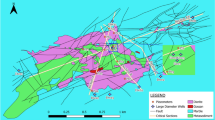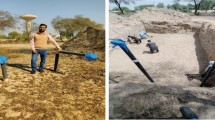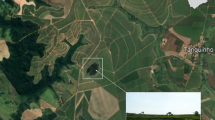Abstract
Heat exchange between the oil pipeline and the permafrost leads to the geotemperature redistribution and permafrost degradation, threatening the pipeline stability. The water redistribution during freeze–thaw cycles affects the physical and mechanical properties of soil and induces heat convection. However, the hydro-thermal process of unsaturated soil around pipeline in permafrost regions still lacks comprehensive analysis. For this problem, a numerical hydro-thermo-vapor coupling model fully considering the contribution of vaporous water to water redistribution and the thermal effect of water migration in unsaturated soil was established, and the soil water and temperature distributions were analyzed. The results show that: (1) The proposed model is feasible to simulate the hydro-thermal process of soil during freezing process. (2) Oil pipeline significantly degrades underlying permafrost. The thermal effect of water migration deepens the permafrost table and aggravates the permafrost degradation. (3) Soil water not only accumulates near the permafrost table, but also migrates toward the pipeline bottom in the form of vaporous water. The influence of pipeline on permafrost is underestimated only from the aspect of temperature. The water redistribution should also be considered to evaluate the pipeline stability. (4) Insulation layer can effectively maintain the thermal state of permafrost. Water accumulation on the pipeline side will lead to soil slide downward, which is a potential threat to pipeline stability.












Similar content being viewed by others
References
Andersland OB, Ladanyi B (2004) Frozen Ground Engineering. John Wiley & Sons
Xu X, Wang B, Fan C, Zhang W (2020) Strength and deformation characteristics of silty clay under frozen and unfrozen states. Cold Reg Sci Technol 172:102982
Zhou Y, Guo D, Qiu G et al (2000) Permafrost in China. Science Press, Beijing, China
Mu Y, Ma LG, W, et al (2020) Rapid permafrost thaw induced by heat loss from a buried warm-oil pipeline and a new mitigation measure combining seasonal air-cooled embankment and pipe insulation. Energy 203:117919
He R, Jin H (2010) Permafrost and cold-region environmental problems of the oil product pipeline from Golmud to Lhasa on the Qinghai-Tibet Plateau and their mitigation. Cold Reg Sci Technol 64(3):279–288
Cai Y, Wang K, Zhang S et al (2014) Causes and counter-measures for exposed pipeline in frigid zone. Oil Gas Stor Transp 33(5):484–487
Razaqpur AG (1989) Beam-column element on weak Winkler foundation. J Eng Mech 115(8):1798–1817
Limura S (2004) Simplified mechanical model for evaluating stress in pipeline subject to settlement. Constr Build Mater 18(6):469–479
Yatabe H, Fukuda N, Masuda T et al (2004) Analytical study of appropriate design for high-grade induction bend pipes subjected to large ground deformation. J Offshore Mech Arct Eng 126(4):376–383
Wang Y, Jin H, Li G (2016) Investigation of the freeze-thaw states of foundation soils in permafrost areas along the China-Russia Crude Oil Pipeline (CRCOP) route using ground-penetrating radar (GPR). Cold Reg Sci Technol 126:10–21
Wang F, Li G, Ma W et al (2018) Permafrost thawing along the China-Russia Crude Oil Pipeline and countermeasures: A case study in Jiagedaqi, Northeast China. Cold Reg Sci Technol 155:308–313
Xu G, Qi J, Jin H (2010) Model test study on influence of freezing and thawing on the crude oil pipeline in cold regions. Cold Reg Sci Technol 64(3):262–270
Huang L, Sheng Y, Wu J et al (2020) Experimental study on mechanical interaction between buried pipe and soil during freezing. Cold Reg Sci Technol 178:103129
Li M, Ma Q, Luo X et al (2021) The coupled moisture-heat process of a water-conveyance tunnel constructed by artificial ground freezing method. Cold Reg Sci Tech 182:103197
Hobiny A, Alzahrani F, Abbas IA et al (2020) The effect of fractional time derivative of bioheat model in skin tissue induced to laser irradiation. Symmetry 12:1–10
Dahab SM, Abbas IA (2011) LS model on thermal shock problem of generalized magneto-thermoelasticity for an infinitely long annular cylinder with variable thermal conductivity. Appl Math Model 35:3759–3768
Abbas IA, Dahab SM (2014) On the numerical solution of thermal shock problem for generalized magneto-thermoelasticity for an infinitely long annular cylinder with variable thermal conductivity. J Comput Theor Nanosci 11:607–618
Li G, Sheng Y, Jin H et al (2010) Development of freezing-thawing processes of foundation soils surrounding the China-Russia Crude Oil Pipeline in the permafrost areas under a warming climate. Cold Reg Sci Technol 64(3):226–234
Mu Y, Chai M, Li G et al (2020) Thermal influence of ponding and buried warm-oil pipelines on permafrost: a case study of the China-Russia Crude Oil Pipeline. Sci Cold Arid Reg 12(2):59–70
Shi R, Wang X, Wen Z et al (2021) Estimates on thermal impact of gas-line and alleviating effect of countermeasures in patchy permafrost of northwestern China. Bull Eng Geol Env 80:2601–2616
Yu W, Liu W, Lai Y et al (2014) Nonlinear analysis of coupled temperature-seepage problem of warm oil pipe in permafrost regions of Northeast China. Appl Therm Eng 70(1):988–995
Wang T, Zhou G, Yin L et al (2019) Estimation on the influence of seepage on stochastic thermal regime of frozen ground surrounding the crude oil pipeline. Cold Reg Sci Technol 157:13–20
Li H, Lai Y, Li L (2019) Impact of hydro-thermal behaviour around a buried pipeline in cold regions. Cold Reg Sci Tech 171:102961
Jin H, Yu W, Gao X et al (2006) Stability of engineering foundations of oil pipelines in permafrost regions. Oil Gas Stor Transp 25:13–18
Wang W, Du W, Tang Y et al (2020) Sensitivity of freezing and thawing influence factors of pipeline foundation soil in permafrost region. Oil Gas Stor Transp 39:1155–1164
Gao J, Lai Y, Zhang M et al (2018) Experimental study on the water-heat-vapor behavior in a freezing coarse-grained soil. Appl Therm Eng 128:956–965
Bai R, Lai Y, Zhang M et al (2018) Water-vapor-heat behavior in a freezing unsaturated coarse-grained soil with a closed top. Cold Reg Sci Tech 155:120–126
He Z, Zhang S, Teng J et al (2018) A coupled model for liquid water-vapor-heat migration in freezing soils. Cold Reg Sci Tech 148:22–28
Saito H, Simunek J, Mohanty BP (2006) Numerical analysis of coupled water, vapor, and heat transport in the vadose zone. Vadose Zone J 5(2):784–800
Zhang M, Wen Z, Xue K et al (2016) A coupled model for liquid water, water vapor and heat transport of saturated-unsaturated soil in cold regions: model formulation and verification. Environ Earth Sci 75:1–19
Hobiny AD, Abbasab IA (2018) Theoretical analysis of thermal damages in skin tissue induced by intense moving heat source. Int J Heat Mass Tran 124:1011–1014
Philip JR, de Vries DA (1957) Moisture movement in porous materials under temperature gradients. Trans Am Geophys Union 38(2):222–232
Bai R, Lai Y, Zhang M et al (2020) Study on the coupled heat-water-vapor-mechanics process of unsaturated soils. J Hydrol 585:124784
Van Genuchten M (1980) A closed-form equation for predicting the hydraulic conductivity of unsaturated soils. Soil Sci Soc Am J 44:892–898
Bai R, Lai Y, Zhang M et al (2018) Theory and application of a novel soil freezing characteristic curve. Appl Therm Eng 129:1106–1114
Mualem Y (1976) A new model for predicting the hydraulic conductivity of unsaturated porous media. Water Resour Res 12:513–522
Nassar IN, Horton R (1992) Simultaneous transfer of heat, water, and solute in porous media: I. Theoretical development. Soil Sci Soc Am J 56:1350–1356
Millington RJ, Quirk JP (1961) Permeability of porous media. Trans Faraday Soc 57:1200–1207
Mohamed RA, Abbas IA et al (2009) Finite element analysis of hydromagnetic flow and heat transfer of a heat generation fluid over a surface embedded in a non-Darcian porous medium in the presence of chemical reaction. Comm Nonlinear Sci Numer Simul 14:1385–1395
Abbas IA (2014) Fractional order GN model on thermoelastic interaction in an infinite fibre-reinforced anisotropic plate containing a circular hole. J Comput Theor Nanosci 11:380–384
Mizoguchi M (1990) Water heat and salt transport in freezing soil. Ph.D. thesis. University of Tokyo
Hansson K, Simunek J, Mizoguchi M et al (2004) Water flow and heat transport in frozen soil: numerical solution and freeze-thaw applications. Vadose Zone J 3(2):693–704
Tan X, Chen W, Tian H et al (2011) Water flow and heat transport including ice/water phase change in porous media: Numerical simulation and application. Cold Reg Sci Tech 68(1–2):74–84
Ma W, Zhang L, Yang C (2015) Discussion of the applicability of the generalized Clausius-Clapeyron equation and the frozen fringe process. Earth Sci Rev 142:47–59
Yu W, Han F, Liu W et al (2016) Geohazards and thermal regime analysis of oil pipeline along the Qinghai-Tibet Plateau Engineering Corridor. Nat Hazards 83(1):193–209
Zhu L (1988) Study of the adherent layer on different types of ground in permafrost regions on the Qinghai-Xizang Plateau. J Glaciol Geocryol 10(1):8–14
Luo X, Yu Q, Ma Q et al (2020) Study on the heat and deformation characteristics of an expressway embankment with shady and sunny slopes in warm and ice-rich permafrost regions. Transp Geotech 24:100390
Zhang J, Qu G, Jin H (2010) Estimates on thermal effects of the China-Russia crude oil pipeline in permafrost regions. Cold Reg Sci Tech 64(3):243–247
Li G, Ma W, Wang X et al (2015) Frost hazards and mitigative measures following operation of China-Russia crude oil pipeline. Rock Soil Mech 36(10):2963–2973
Wang W, Zhang X, Yang X et al (2019) Study on the distribution characteristics of freeze injury along China-Russia Crude Oil Pipeline. Oil Gas Field Surf Eng 38(9):52–58
Ma Q, Luo X, Lai Y et al (2018) Numerical investigation on thermal insulation layer of a tunnel in seasonally frozen regions. Appl Therm Eng 115:670–681
Acknowledgements
This research was supported by the Second Tibetan Plateau Scientific Expedition and Research (STEP) Program (No. 2019QZKK0905), China Postdoctoral Science Foundation (No. 2021TQ0114), Natural Science Foundation of Guangdong Province (No. 2021A1515110408), Open Fund of the State Key Laboratory of Frozen Soil Engineering (No. SKLFSE201810), Science and Technology Projects in Guangzhou (Nos. 202102020486, 202201010262) and Guangdong Provincial Key Laboratory of Modern Civil Engineering Technology (No. 2021B1212040003).
Author information
Authors and Affiliations
Contributions
Tianli Lan: Methodology; Software; Validation; Writing -original draft. Xiaoxiao Luo: Methodology; Review & editing, Formal analysis. Qinguo Ma: Conceptualization; Methodology; Supervision; Validation; Writing review & editing.
Corresponding author
Ethics declarations
Competing interests
The authors declare that they have no known competing financial interests or personal relationships that could have appeared to influence the work reported in this paper.
Additional information
Publisher's Note
Springer Nature remains neutral with regard to jurisdictional claims in published maps and institutional affiliations.
Highlights
• A coupled hydro-thermo-vapor numerical model for unsaturated soil is established
• Water migration impacts on the temperature distribution of soil around the pipeline
• Temperature and water distributions simultaneously influence the pipeline stability
• The pipeline stability is threatened by freezing damage and downward slide of soil
Rights and permissions
Springer Nature or its licensor holds exclusive rights to this article under a publishing agreement with the author(s) or other rightsholder(s); author self-archiving of the accepted manuscript version of this article is solely governed by the terms of such publishing agreement and applicable law.
About this article
Cite this article
Lan, T., Luo, X. & Ma, Q. Numerical analysis on hydrothermal process around oil pipeline in permafrost regions of Qinghai-Tibet Plateau. Heat Mass Transfer 59, 763–778 (2023). https://doi.org/10.1007/s00231-022-03299-8
Received:
Accepted:
Published:
Issue Date:
DOI: https://doi.org/10.1007/s00231-022-03299-8




